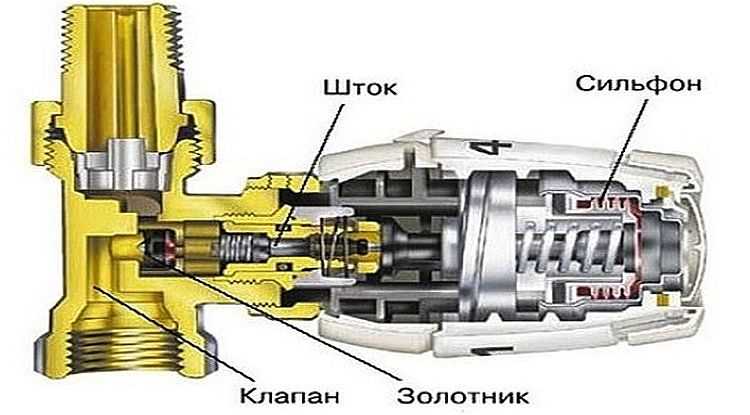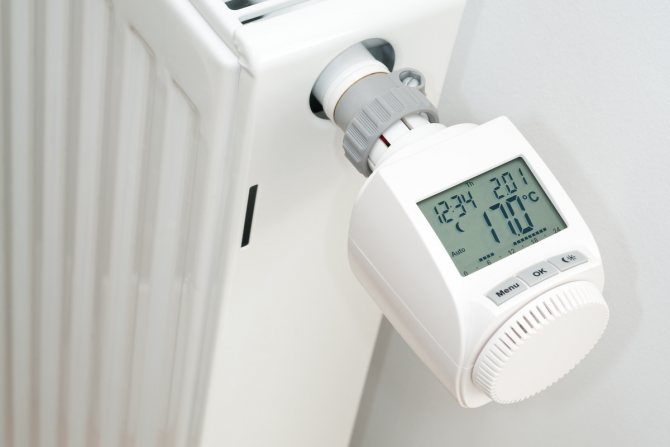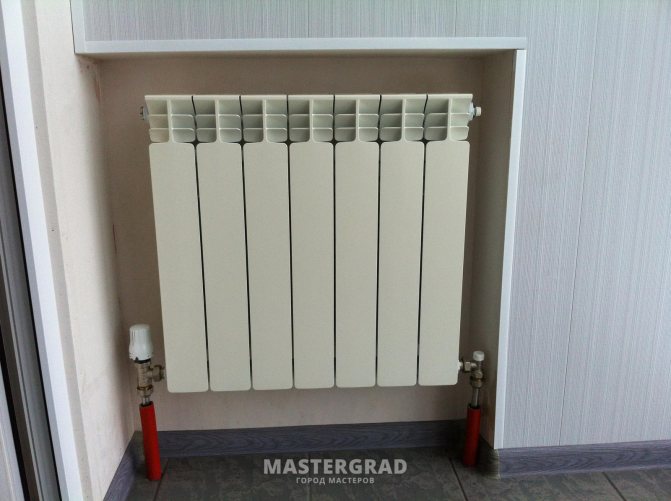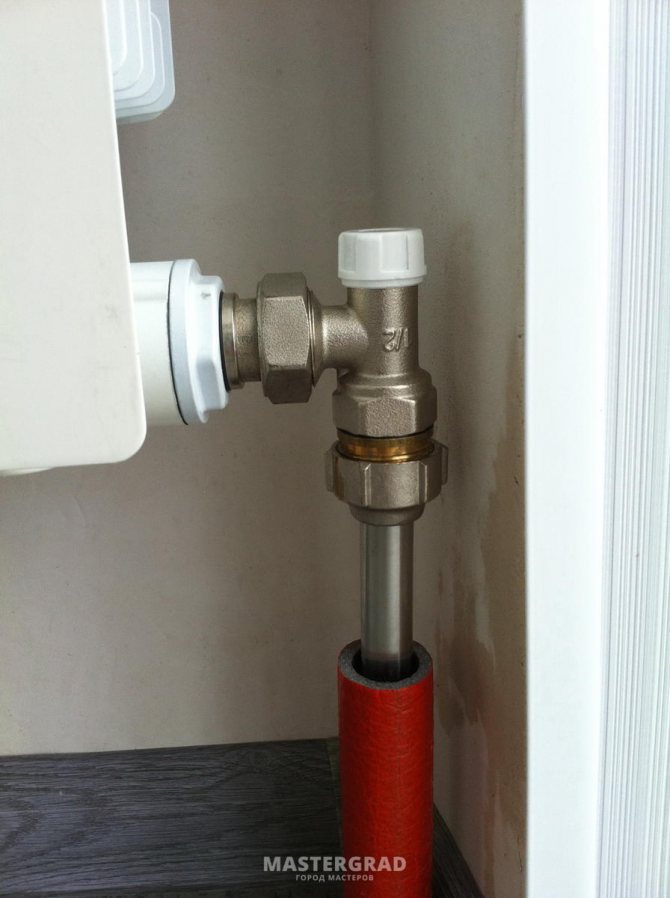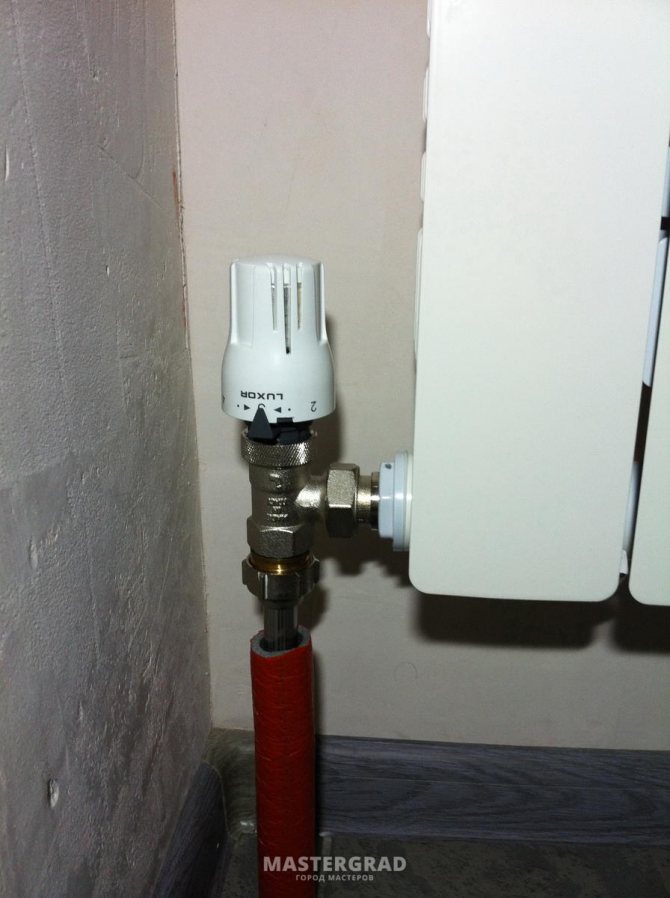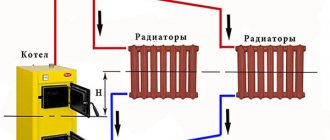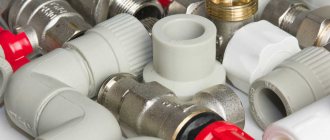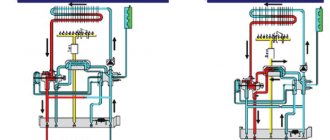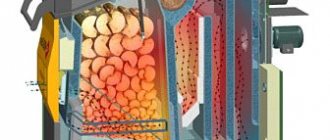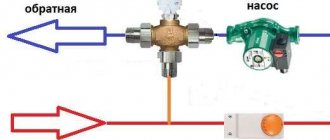Element types
Only the upper replaceable part of the device is called a thermal head. It can be manual, mechanical and electronic. Most of the major manufacturers of this kind of equipment make the valve body fully compatible with all types of thermocouples.
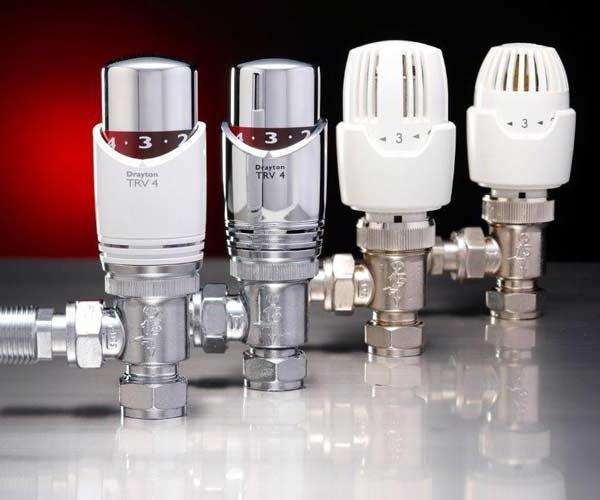
So, if the radiator has a built-in thermostatic valve, then any type of head can be installed on it. The most reliable is a mechanical part equipped with a thermostat.
There are also vandalism-proof models. Systems with remote sensors are available. Such solutions are purchased and installed if the current conditions do not allow temperature control on the radiator itself. For example, the battery is installed behind a cabinet or dresser. The cost of such models starts from 40 euros.
Manual thermostats are the same radiator control valves. The principle of operation is the same here.
Installation features
When installing a thermal head on a heating radiator, the main requirement should be taken into account: it must be freely "flowed" with air. Its installation is undesirable:
- behind the curtains;
- under the windowsill;
- in a draft;
- where the sun's rays will fall.
If these requirements are not taken into account, the temperature measurements will not correspond to the true values of the entire room. As a result, the work will be ineffective. If, nevertheless, the thermal head is installed in one of these places or access to it is limited, you can equip it with an additional remote sensor and regulator.
Thermal valve for heating radiator classification
Now let's talk about the bottom of the thermostat - the valve (valve). First of all, you need to know that the industry produces control devices for different systems. And you only need to use the devices for your system.
Devices for two-pipe systems have at least twice the hydraulic resistance than for single-pipe systems. This is done on purpose, since balancing in this case occurs due to the pressure drop across the valves. Therefore, devices with a small flow area are installed. By placing such a device in a one-pipe system. you will be freezing for sure. Therefore, be careful.
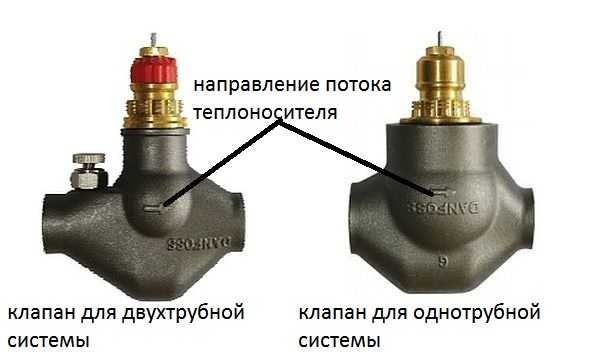

There are thermal valves for radiators in one-pipe and two-pipe systems. And it is impossible to use devices for a two-pipe system in a one-pipe system.
Sometimes modifications for one-pipe systems are positioned as devices for systems with natural circulation. They have reduced hydraulic resistance and can be used in single tubes.
In a one-pipe system, install thermostats with a flow capacity of at least 3 (Kvs = 3 and higher).
According to the method of piping, radiator temperature regulators are angular or straight (straight through). There are also axial models. In this case, they are chosen depending on the type of connection of the heater. If the pipe fits from the side, it is more convenient to put a straight valve, if from below - one of the angled ones.
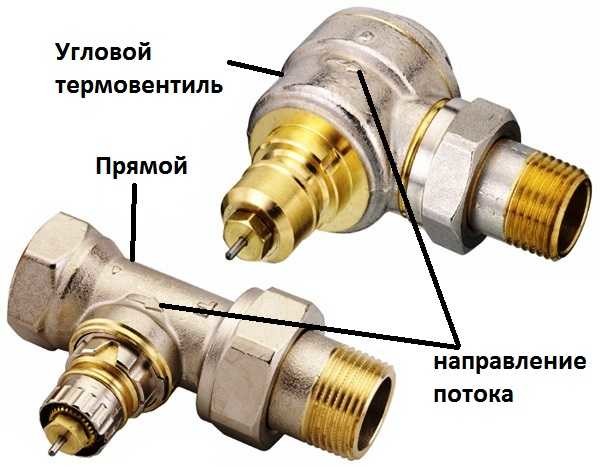

By the type of connection, thermostatic valves for radiators are straight and angled
Thermal valves also differ in the material from which they are made. Metals are used that have good corrosion resistance. On some of them an additional protective coating is applied (usually nickel or chrome plating). So, thermostatic valves are made from:
- bronze, nickel-plated and chrome-plated;
- brass, nickel-plated;
- stainless steel.
It is clear that stainless steel is better, but such valves cost a lot, and are rarely found on sale.
Thermostatic heads
There are three types of thermostatic elements for heating thermostats - manual, mechanical and electronic. They all perform the same functions, but in different ways, provide different levels of comfort, and have different capabilities.
Manual thermostatic heads work like a regular tap - turn the regulator to one side or the other, letting in more or less coolant. The cheapest and most reliable, but not the most convenient device. To change the heat transfer, you must manually turn the valve.


Manual thermal head - the simplest and most reliable option
These devices are quite inexpensive, they can be installed at the inlet and outlet of the heating radiator instead of ball valves. It will be possible to regulate any of them.
Mechanical
A more sophisticated device that maintains the set temperature in automatic mode. The basis of this type of thermostatic head is a bellows. It is a small elastic cylinder filled with a thermal agent. A thermal agent is a gas or liquid that has a high coefficient of expansion - when heated, they greatly increase in volume.
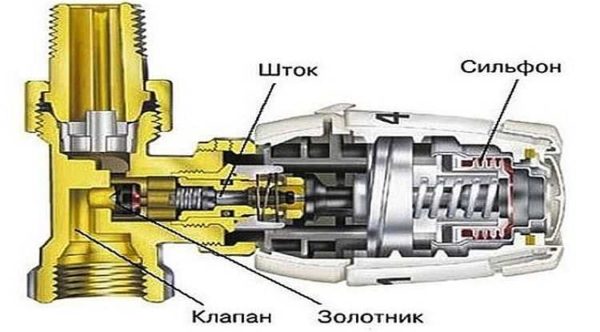

Thermostat device for a heating radiator with a mechanical thermostatic head
The bellows supports the stem that overlaps the flow area of the valve. Until the material in the bellows is heated, the stem is raised. As the temperature rises, the cylinder begins to increase in size (gas or liquid expands), it presses on the rod, which more and more overlaps the flow area. Less and less coolant passes through the radiator, it gradually cools down. The substance in the bellows also cools down, due to which the cylinder decreases in size, the rod rises, more coolant passes through the radiator, it starts to warm up a little. Then the cycle is repeated.
Gas or liquid
In the presence of such a device, the temperature in the room is fairly maintained at exactly + - 1 ° C, but in general the delta depends on how inert the substance in the bellows is. It can be filled with some kind of gas or liquid. Gases react faster to temperature changes, but they are more difficult to produce technologically.
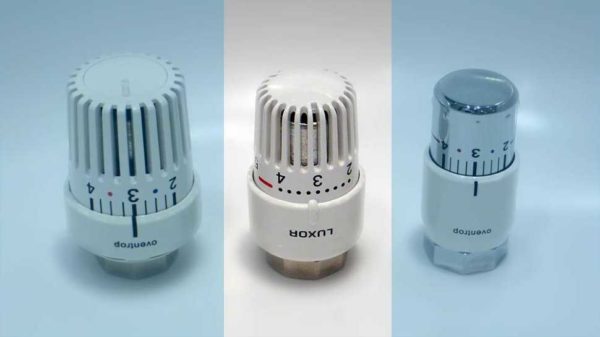

Liquid or gas bellows - not much difference
Fluids change volumes a little more slowly, but are easier to manufacture. In general, the difference in the accuracy of maintaining the temperature is about half a degree, which is almost impossible to notice. As a result, most of the presented thermostats for heating radiators are equipped with thermal heads with liquid bellows.
With remote sensor
The mechanical thermostatic head must be installed so that it is directed into the room. This way the temperature is measured more accurately. Since they have a fairly decent size, this installation method is not always possible. For these cases, you can supply a thermostat for a heating radiator with an external sensor. The temperature sensor is connected to the head using a capillary tube. It can be positioned at any point where you prefer to measure the air temperature.
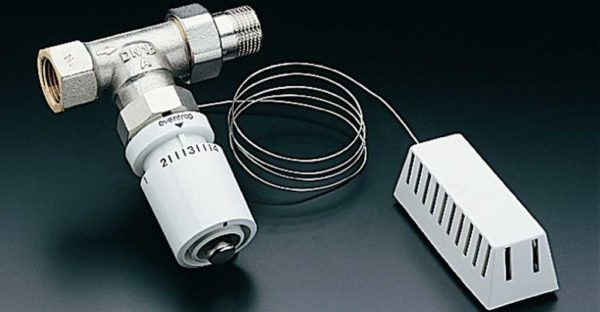

With remote sensor
All changes in the heat transfer of the radiator will occur depending on the air temperature in the room. The only drawback of this solution is the high cost of such models. But the temperature is maintained more accurately.
Electronic
The size of the electronic thermostat for a heating radiator is even larger. The thermostatic element is even larger. In addition to electronic filling, two batteries are also installed in it.


Electronic thermostats for batteries are large
In this case, the movement of the stem in the valve is controlled by a microprocessor. These models have a fairly large set of additional functions. For example, the ability to set the room temperature by the clock. How is it fashionable to use it? Doctors have long proven that it is better to sleep in a cool room. Therefore, at night, you can program the temperature lower, and by morning, when it’s time to wake up, it can be set higher. Conveniently.
The disadvantages of these models are their large size, the need to monitor the discharge of the batteries (enough for several years of operation) and the high price.
The principle of operation of the thermal head
The air temperature near the thermal head affects the state of the substance in the bellows container. Increasing or decreasing in volume, the substance acts on the position of the rod, thereby regulating the volume of the coolant entering the radiator.
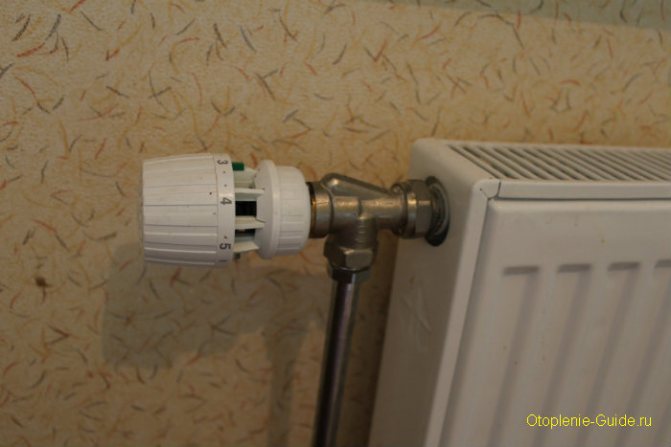

Danfoss thermostat on a panel radiator.
If the air temperature in the room rises, the substance in the bellows begins to expand, squeezing out the rod, which in turn reduces the channel cross-section, and the volume of the coolant entering the radiator decreases. With a decrease in temperature, the opposite process occurs: the substance in the bellows is compressed, due to which the rod rises, increasing the channel cross-section, and the volume of the incoming coolant increases.
Opening and closing of the stem is facilitated by two stainless steel springs: one returns the stem after closing the valve, the other after opening.
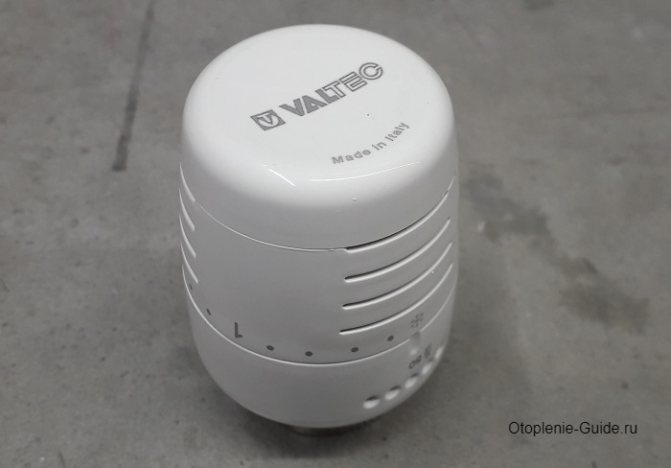

Valtec VT.5000.0. Liquid, bellows filler - toluene.
Note! One of the most common problems with thermostats is the sticking of moving elements during their long inactivity (or if the settings were fixed for a long period of time). This is especially true for thermostatic valves with a pressure force of up to 2 kg on the stem. To solve this problem, you should install devices with a pressure force of 4 kg. In addition, after the end of the heating season, it is recommended to remove the thermal heads from the valves, which will extend their service life.
For the thermal head to function properly, it must be periodically cleaned of dust and dirt. It should be remembered, however, that cleaning agents and abrasive materials should not be used for cleaning.
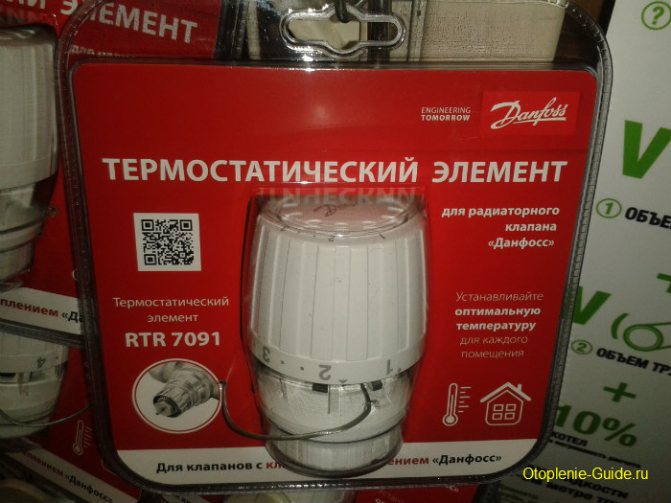

Thermostatic element RTR 7091 for Danfoss radiator valve.
Thermal agent types
Most often, liquid and gas are used in its role. Because of this, the following types of thermal heads are distinguished:
Regulators of the first type are cheaper and simpler. For this reason, they are represented by a very large number of models. However, they run the battery more slowly.
The gas regulator for the heating battery has less inertia, due to which it is able to react quickly enough to changes in the room temperature.
In practice, the difference between the two types of response is very small.
Therefore, when choosing, it is better to focus on the quality of performance. It also depends on the manufacturer.
Almost all types of thermostats are capable of setting the temperature, the range of which is + 6 ... + 28 ° С. There are, of course, options to accommodate other temperature levels. However, as the temperature range rises, the price rises.
Types of heads by design
There are thermostatic devices according to the type of design. They are selected depending on the characteristics of the pipeline of a particular heating system and the method of installation to the radiator.
It is necessary to take into account the peculiarity of the head installation. This node was always located horizontally. In this position, the device will be more efficient. The head will be better able to be washed by air currents.
On sale there are independent devices without radiator valves or together with them.The Danfoss thermostatic valve, for example, has just such an arrangement. But the company makes completely different systems. Instead of a scale, this product has a special diagram, which can be used to fine-tune the settings.
But it is not always advisable to use such equipment. In this case, instead of automatic solutions, other types of valves can be used. The difference here is that the adjustment is carried out not automatically, but in manual mode. Adjustable valves and thermal heads are installed on the flow line. It is recommended to install simpler fittings at the return outlet from the battery.
Thermostatic heads
- devices of a cylindrical shape, inside which there is a working substance that reacts to changes in air temperature. When the temperature changes, the volume of the working substance changes, as a result of which the valve closes. Typically, thermostatic heads regulate the temperature in the range of -6 to +30 degrees.
Thermal heads can have different working substances (liquid, gas, etc.). The range of Heimeier liquid thermostatic heads is very large. Their main advantage is an increased level of accuracy, quiet operation, simplicity and ease of use.
Gas condensate thermal heads are more sensitive to temperature changes and react more quickly to temperature changes in the room.
Most of the models of thermal heads are equipped with built-in or remote sensors, which are respectively located in the housing of the thermostatic head or outside (connection to the sensor is made using a thin metal tube).
It should be remembered that the installation of thermal heads with a built-in sensor is not so easy. For a thermostatic head of this type to work with maximum efficiency, the following conditions must be met: the depth of the radiator is not less than 16 cm, the width of the window sill is not more than 22 cm, and the distance from the window sill to the radiator is not more than 10 cm.In cases where these requirements are not possible complete, it is recommended to use thermal heads with a remote sensor, which can be located at a distance of 2 to 8 meters from the thermal head.
Installing the thermal head on the radiator
The connection of each specific model of the thermal head must be carried out in accordance with the manufacturer's recommendations, which are indicated in the operating instructions. However, it is possible to highlight the general installation requirements that are typical for most models:


Correct installation of the thermal head.
- Direct sunlight should not fall on the housing, as this will lead to incorrect operation of the device;
- Various interior items (furniture, protective boxes, curtains, decorative radiator grilles, window sills, etc.) should not "hide" the thermal head of the heating radiator from the rest of the room. In addition, it should not be located above the ascending streams of heated air (for example, above the heating pipes). Otherwise, the air temperature near the head will be higher than the temperature in the rest of the room;
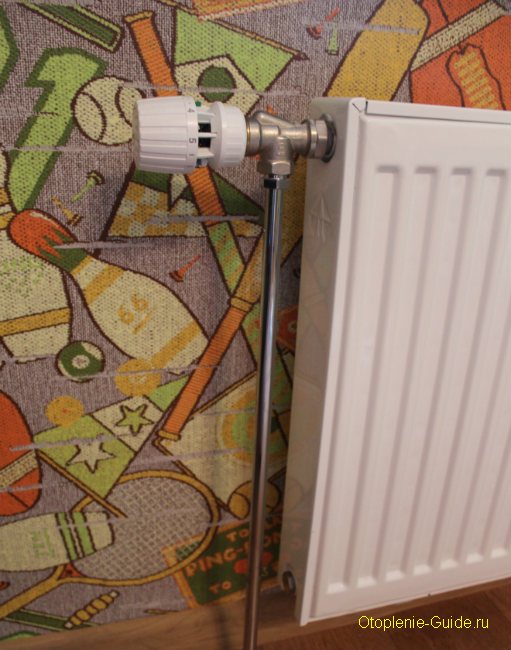

Danfoss thermostatic head on steel panel radiator.
Advice! If, nevertheless, the thermostatic valve is closed by some interior item, then it is recommended to use a thermal head with an external sensor. The sensor is mounted on a wall, in a place where it is not exposed to heat from heating system elements, direct sunlight, drafts, etc. The sensor is connected to the head using a 2-3 m capillary tube (maximum 8 m).
- If the thermostatic head is in a practically closed position, then for the correct circulation of the coolant through the heating system, it is recommended to install a bypass valve or a bypass line between the supply and return;
- The thermostatic valve body must not experience any pressure from the connected piping.
Installing a thermostat on a radiator
Radiator thermostats are mainly installed on the flow in front of the heater inlet. Each of the valves passes the coolant in one direction. Where the flow should go is shown by an arrow on the body. The coolant must flow exactly there. If connected incorrectly, the device will not work. Another question is that you can put a thermostat, both at the inlet and at the outlet, but observing the direction of flow. And in both cases they work the same way.
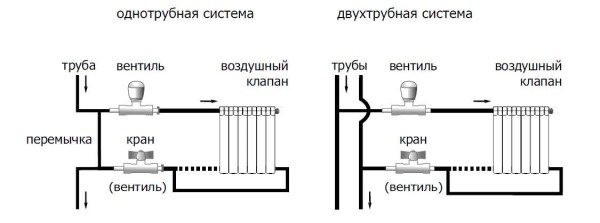

Variants of connection and installation of control valves. But to be able to repair the radiator without stopping the system, you need to put a ball valve up to the regulator (click on the picture to increase its size)
It is worth paying attention to the manufacturer's recommendations regarding the installation height. Most models should be 40-60 cm above the floor
They are calibrated to temperatures at this level. But not everywhere the feed is top. Often radiators have a bottom connection. Then, in addition to the type of system (one-pipe or two-pipe), select the installation height. If such a model is not found, you can set a lower temperature on the thermal head. If you put the recommended one, it will be too hot, since the air is cooler below, in the area of the floor, and the model is set to maintain the temperature measured at the height of the upper edge of the radiator. The second option is to configure the device yourself. The procedure is usually described in the passport, and the most common sequence of actions is described below. And the third option is to put a thermostat with an external sensor on the battery. Then it is absolutely all the same at what height the thermal head is. The main thing is the location of the sensor. But such models are much more expensive. If this is critical, it is better to tune the regulator.
Please note that the thermostatic head must be turned horizontally (looking into the room). If it is fused upward, then it is constantly in the stream of hot air that comes from the pipe.
Therefore, the substance in the bellows is almost always heated, and the radiator is turned off. The result is that the room is cold.
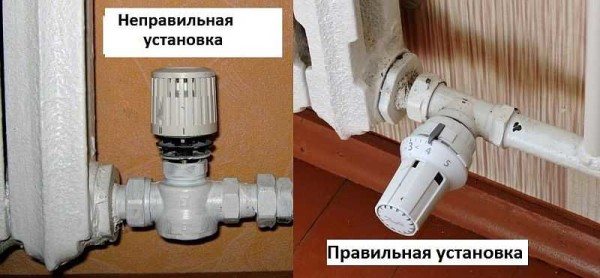

For the device to work correctly, you need to install it "head" in the room
The situation is slightly better if the battery is installed in a niche, covered by a screen or curtain. The thermocouple is also "hot" but not so hot. Here you can go in two ways: either set a higher temperature on the regulator, or use an external sensor. Models with external thermal controllers are, of course, not cheap, but you can choose the control point of your choice.
Another thing to remember: when installing in a one-pipe system, a bypass is required. Moreover, it is unregulated. Then, when the supply on the radiator is closed, the riser will not be blocked, and you will not receive "hello" from the neighbors.
Thermal valves also differ in the type of connection: there are they with union nuts, there are crimped ones. Accordingly, they are joined with certain types of pipes. Typically, the specification or product description indicates the type of connection, as well as with which pipes it can be used.
Incorrect installation of the heating radiator thermal head
Good day!
I bought an apartment in a new building. The developer carried out the heating wiring with bottom connection (Rehau), installed bimetallic radiators, Danfoss thermostatic heads with a remote sensor, and connected an individual heating agent meter.
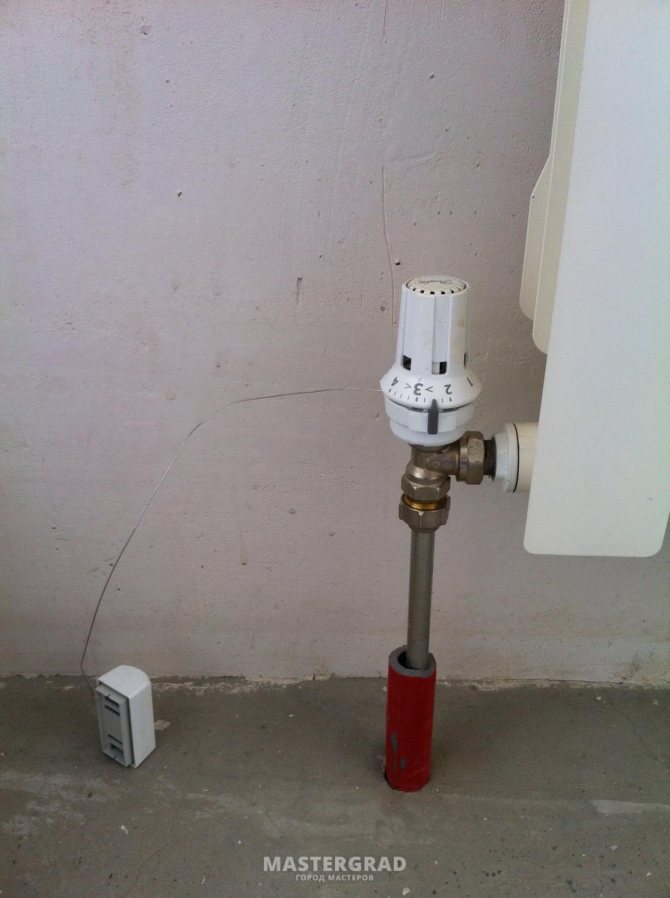

I decided to add a heating radiator to the glazed loggia, like this:
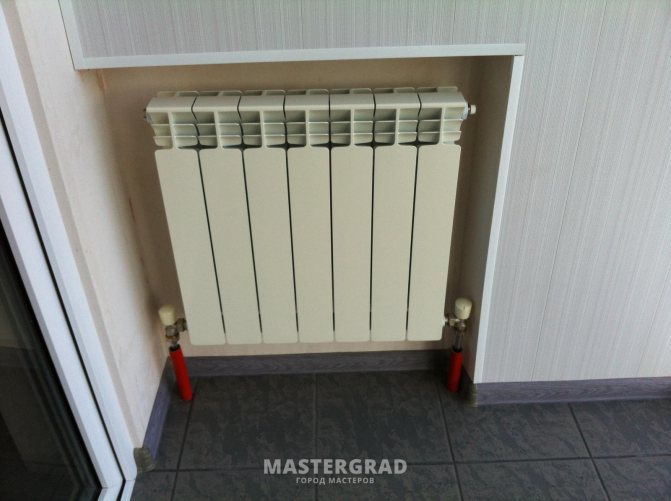

During installation, the plumber dissuaded from installing the thermal head. Moreover, he recommended removing the rest, replacing them with ordinary manual valves.
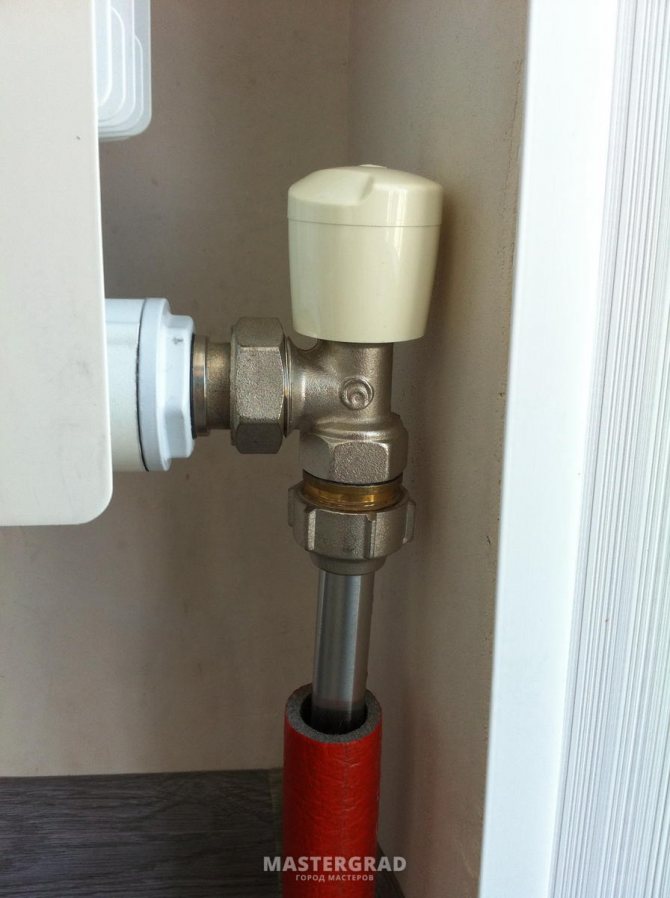

Motivation: thermal heads are capricious, often work incorrectly, “everyone takes them away,” etc. I'm glad I didn't listen to his advice.As time has shown, this system not only perfectly maintains the set temperature, but also allows you to significantly save when paying for heat. But the battery on the loggia had to be adjusted manually, and since the apartment is not residential (finishing is not yet completed), we rarely visit it, the heat consumption on this radiator was unreasonably high. I wanted to do it correctly and beautifully, and I, like all amateurs, arrogantly decided that there was nothing complicated here and I could do everything myself, without resorting to the services of a specialist. It was decided to assemble the system based on the batteries in the room. To do this, I bought the following parts (I give the full name from the sales receipt):
- "Valve ½ gsh term. coal with cr. ITAP 994 C "- 1 pc.
- "Angle reverse valve ½ gsh ITAP 396" - 1 pc.
But there was a problem with the thermal head. The Danfoss head with a remote sensor cost about 2 thousand rubles in the store, which seemed a little expensive to me. Then the seller offered an economy option: a Luxor TT3000 head worth 700 rubles, the sensor of which was located inside the head itself. Having decided that for the loggia "it will do anyway", I did a stupid thing and bought Luxor. I assembled the system without any problems; checked - no leaks, set the adjustment to "3" (in the middle) and left pleased with himself.
Returning two or three weeks later, he found that the apartment was warm as usual; all the radiators in the rooms were either cold or barely warm. It was only on the loggia that it was noticeably hot, but despite this the battery was drawing with might and main. "Something went wrong…"
Only after that I read the instructions for the head on the Internet. It turns out that it should be installed horizontally, not vertically. And it is also forbidden to install it on a battery that is located in a niche or under a windowsill. The instructions explicitly state this:
“Caution: thermostatic heads should not be installed under windowsills, in a niche, in the path of warm air, in an upright position, or behind a curtain. Incorrect installation of the head leads to the formation of excess heat in the immediate area of the head. In this case, the temperature perceived by the sensor will differ from the real temperature in the room. "
Well, it is shown in the pictures:
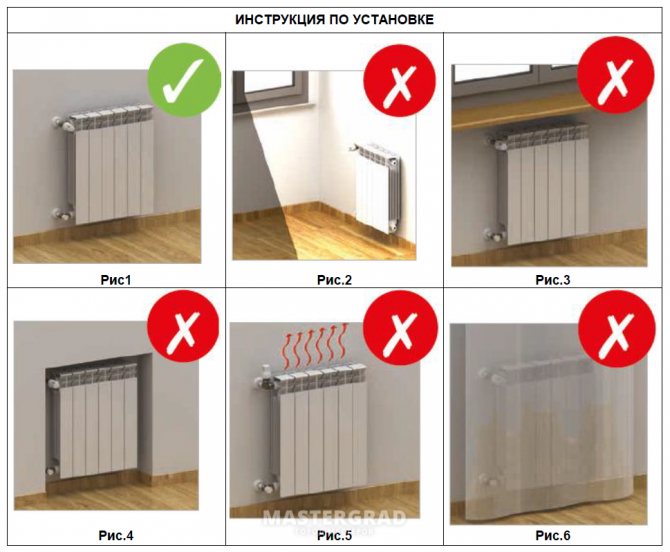

"Nothing wrong!" - I decided. “Well, the temperature will be different - and to hell with it. You just need to find the desired adjustment position. For a loggia and so it will come down! " I set the adjustment to "2" and left. On the next visit, everything was repeated: it is warm on the loggia, and the battery is hot. I tried to unscrew the adjustment to a minimum - it overlaps. To the maximum, it opens. That is, the thermostatic valve works, but the head does not. And if the sensor was wrong, then it should have been colder on the loggia than in the apartment; after all, being in close proximity to the battery - and also in a niche - the sensor should overheat and supply less heat, but, on the contrary, it supplies more. It turns out that the whole system works like a manual valve and nothing more.
At first I decided to replace the thermostatic valve with a horizontal one in order to properly install the head, but then I abandoned this idea. Firstly, the head will still be located in the corner of the niche, which may cause the temperature to be determined incorrectly. Secondly, I mortally do not want to disassemble the system again. Easier - although at times more expensive! - change the head to another with a remote sensor. A miser pays twice ... I also decided to buy an ITAP thermal head, namely ITAP 891SD, just in case, so that all the parts were of the same brand. Maybe this is how the system will work most correctly? (although this is probably nonsense). The price tag of the ITAP 891SD is just a horse, but where to go! And so, I look in advance in the installation instructions for ITAP 891SD, and I see the same warning there: vertical installation - "NO"!
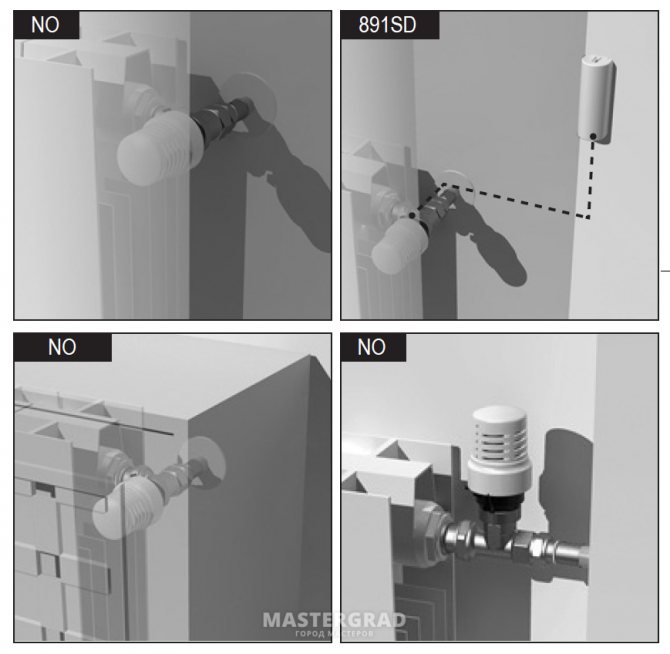

But what the hell ?! There is no sensor in the head, it is external! Then why "NO" ?! Danfoss with a remote sensor, installed vertically, works great in an apartment, but it has a different attachment to the thermo-valve, so I could not remove it and connect it to the battery on the loggia for testing. Other ideas no longer come to mind.
I very much ask the specialists to recommend a thermal head with an external sensor, which can be installed vertically and connected to the ITAP 994 C thermo valve, or another modification method that will finally make the heating system on the loggia work correctly. Thanks!
Thermal valve features
It was mentioned earlier that it is universal, that is, any type of thermal head can be installed on it. However, despite this, it has two varieties. They depend on which heating system the tap is to be used in. one-pipe or two-pipe.
The varieties of a thermal valve should not be neglected, because by installing a valve for a two-pipe system in a one-pipe system. the radiator will not warm up well. The reason for this is that the shut-off valve for a 2-pipe system has a high flow resistance. In fact, it is twice that of valves for a 1-pipe system. To achieve this resistance, manufacturers make small bore sizes. It also allows you to reduce the pressure on the valves and balance the pressure in the system. Because of this, under the condition of low pressure (typical for a 1-pipe system), little coolant enters through the valve.
For 1-pipe systems, valves with a flow capacity equal to or greater than 3 are suitable.
It is very simple to mount an electronic thermostat on a battery. To do this, perform the following actions:
- Shut off the riser and drain the water.
- A piece of pipe is cut off from the radiator. Its length must match the length of the thermostatic valve. In fact, the pipe is cut in one place.
- Dismantle the part of the pipe that remains in the radiator. These steps are not performed if the heating system is only being created or if there is a valve with the same dimensions as the required valve.
- Unscrew the fitting with the American from the thermo valve.
- The fitting is fixed in the radiator, and the base of the faucet on the pipe.
- A tap is applied to the fitting in the radiator and the American is tightened. The valve should be positioned so that the stem "points" to the side.
- An electronic or mechanical thermal head is fixed.
The installation features are as follows:
- the thermostat is usually placed on the inlet pipe. In this case, the arrow on it must coincide with the direction of movement of the coolant;
- the electronic device must always be in a horizontal position. It is forbidden to place the thermal head over the pipe. This is because the heat from the pipe will heat the cylinder and cause unnecessary shut-off of the radiator. The consequence is a cold room;
- most electronic and mechanical controls are set up for mounting at a height of 40-60 cm. If placed at a height of 10-15 cm (bottom battery connection), the room will be too warm. The problem with the bottom connection can be solved by reconfiguring the thermostat, using an external sensor or purchasing a specially designed regulator;
- if the heating system is one-pipe, then the inlet and outlet pipes are correctly connected with an additional pipe. That is, it is necessary to create a bypass.
How to properly install the thermal head on the battery
Intermediate positions, when adjusting the water flow, can lead to rapid wear of the locking mechanism and its leakage.
A flare valve is a more suitable "candidate" since this valve may not be fully open / closed.
Important. The crane must be returned to its original position after a while.
Adjustment is carried out manually.
Regulation of batteries using an automatic regulator, otherwise, a thermostat, is carried out according to several schemes, depending on the type of heating system.
Thermostats for one-pipe heating systems
The principle of such adjustment
They are installed only if there is a connecting part between the pipes (bypass), which ensures the constant movement of water in the battery to the radiator from the coolant.
Read more about the purpose, design of the bypass here: https://kvarremontnik.ru/bajjpas-dlya-otopleniya/
For any type of heating system, the thermostat is installed in front of the radiator / radiator, strictly in a horizontal position. This compensates for the heating of the pipe and the thermostat.
When installing a control valve, the direction of movement of the heat flux must be taken into account: with vertical pipelines, the movement is set along them. On the valve are indicated by arrows in the direction of movement of the coolants.
When installing the regulator on a two-pipe system, the general requirements are observed:
- installation takes place at the place of the jumper (plug) between the batteries and the coolant supply pipe;
- connection is carried out with the heating system turned off and the water drained from the system;
- the thermostat must be installed strictly horizontally.
Special conditions for installing a thermostat
An example of a thermostat
The thermostat works according to the principle: when a certain temperature is reached, the gas inside the regulator expands, shutting off or reducing the supply of hot water.
Therefore, special installation conditions are required in order for the heating radiators to be adjusted correctly:
- The thermostat must not be exposed to direct sunlight.
- It should not be covered by curtains, screens on the battery.
- The air in the room must be ventilated, especially near the device itself.
In addition, its operation is influenced by outside temperatures and sources of cold and heat.
Advice. First of all, thermostats are best installed in rooms with strong temperature fluctuations (kitchens, living rooms), as well as in the upper floors of private houses.
Read more about thermostats and how to work with them. And here is a detailed material on the installation of equipment.
Home comfort
Thermostatic element type
The thermal head for the radiator is the upper, replaceable part of the device. It can be of several types:
So that you can navigate the prices: European manufacturers sell mechanical thermal heads from 15 euros to 25 euros, there are vandal-proof models, they cost from 40 euros. There are devices with a remote sensor. They are installed if conditions do not allow regulating the temperature on the radiator (for example, it is installed behind a cabinet, closed in a niche, etc.). Here, the length of the capillary tube, which connects the sensor to the thermostat, is of great importance. Prices in this segment are from 40-50 euros.
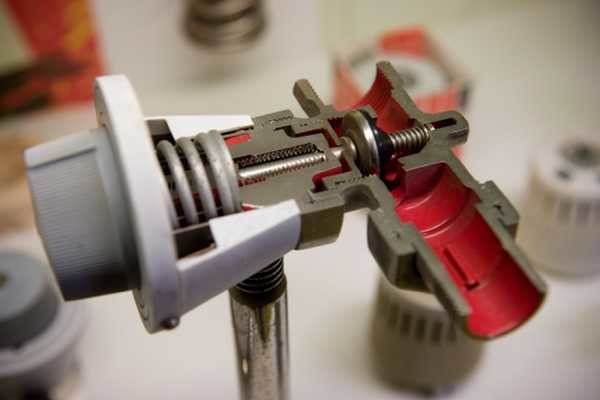

It looks like a manual device for adjusting the temperature of radiators in section
The manual thermostat is the same control valve for the radiator. And the principle of operation is the same: rotate the knob, change the amount of heat carrier passing through. The only difference is that, if you wish, you can simply remove this thermoelement and put in a mechanical or electronic one. At the same time, the case does not need to be unscrewed or changed. They are versatile. Heads for manual adjustment have a low price - from 4 euros.
Electronic thermal heads are the most expensive options, they are also the most massive: there is room for two batteries in the case. They differ in that they have more opportunities. In addition to maintaining a stable temperature throughout the entire time, you can program the temperature by days of the week or by time of day. For example, after 9 am, all household members leave, and appear only after 6 pm. It turns out that there is no need to spend money on maintaining high temperatures during the day.Electronic thermoelements make it possible to set a lower temperature in this interval on all days, except weekends. Put it at least 6-8 ° C, and in the evening you can again heat the air to a comfortable 20 degrees. With these devices, it is possible to save on heating costs without compromising the level of comfort.
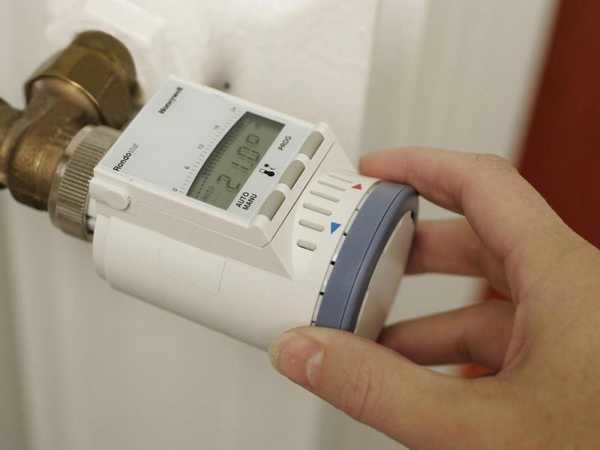

Electronic models have much wider functionality
Thermal heads are also divided according to the type of temperature agent (the substance that is in the bellows). They are:
A gas thermostat is considered less inertial, it is said to react more quickly to changes in temperature. But the difference is not so big as to give preference to a particular species. The main thing is quality, not the type of thermal agent. Liquid thermostats are of no less quality. Moreover, they are easier to manufacture, because they are produced in a wider range.
When choosing a thermocouple, you need to pay attention to the temperature range that the device can support. Usually it is from +6 o C to + 26-28 o C
But there may be differences. The wider the range, the higher the price. Dimensions and design, connection method are also changing.
How does a thermal valve work?
The thermal head is required to adjust the temperature of the radiator.
The very first versions of thermostats that were installed on heating radiators were created in 1943 by the DANFOSS company. Several decades later, such devices have undergone many changes, as a result of which they have become more accurate. Their design consists of several parts: a valve and a thermal head. Moreover, they are connected with a special locking mechanism. The purpose of the thermal head itself is to measure and analyze the temperature and influence it by using a valve mechanism for this, which opens and closes the flow of water into the radiator.
This method of regulation is also called quantitative due to the fact that the device changes the temperature by changing the amount of coolant that passes through the heating radiator. There is also another method called quality. Its principle is to change the temperature of the water directly in the system itself. This is the responsibility of the mixing unit, which is usually installed in the boiler room.
Inside such an element there is a bellows filled with a heat-sensitive medium.
Moreover, the latter can be of several types:
- liquid;
- gas-filled.
It is worth noting that liquid versions are easier to manufacture, but their speed is lower than that of gas ones. The essence of their work is as follows: when the temperature rises, the substance inside, according to the laws of physics, expands, due to this, the bellows expands. Further, the latter reduces the size of the valve section by moving a special cone. Ultimately, the flow rate of the coolant decreases. When the air in the room cools down, the process is reversed.
Options for adjusting the heating radiator with a thermal head
Adjustment can be of two types: quantitative and qualitative.
The principle of the first method is to change the temperature by changing the amount of coolant passing through the radiator.
The second method involves changing the temperature of the water directly in the system. For this, a mixing unit with a siphon filled with a temperature-sensitive medium is installed in the boiler room. This medium can be liquid or gas-filled.
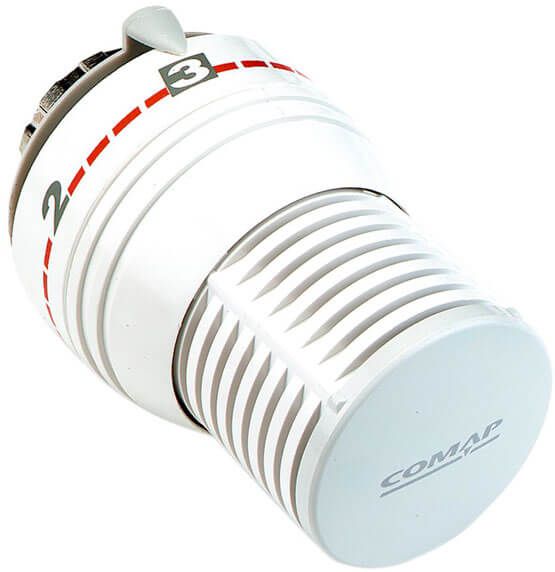

The version with a liquid medium is easy to manufacture, but it acts slower than a gas one. The essence of both options is as follows: when heated, the working medium expands, which leads to the stretching of the siphon. As a result, a special cone moves inside it and reduces the size of the valve section. This leads to a decrease in the flow rate of the coolant. When the air in the room is cooled, the process proceeds in the reverse order.
Danfoss
This company is the inventor of the described equipment. For more than 60 years, the products of this manufacturer have embodied the best quality, high reliability and assortment. This technique can help you save a lot.


Among the popular products are the RA-N thermostatic valve. It is designed for two-pipe systems and has a built-in function for pre-setting the flow rate. The device is made in a durable cast bronze housing and is maximally protected from corrosion.
As you can see, these solutions are a great option when you need to save on heating or when it is very hot in an apartment or house. These devices are capable of making life more comfortable.
Cars Power steering belt: description and principle of operation
Each car has additional auxiliary devices - these are air conditioners, power steering, generators. All of these elements are driven by the engine using drive belts. ...
Cars Fuel supply system. Injection systems, description and principle of operation
The fuel supply system is needed for the flow of fuel from the gas tank, its further filtration, as well as the formation of an oxygen-fuel mixture with its transfer to the engine cylinders. Currently, there are several types ...
Home comfort Pulse relays for lighting control: description and principle of operation
A relay is a device for switching an electrical circuit when the input influences change. The classic version is an electromechanical device that opens or closes contacts when passing ...
Home comfort Sofas, transformation mechanism "accordion": description and operating principle
In modern apartments, sometimes there is not enough space to arrange all the necessary furniture. Therefore, sofas and transformation-type beds are ubiquitous. They serve many functions. This allows…
Home comfort Description and principle of operation of the sandwich maker Maxwell MW-1552
In order to feed the family quickly and tasty at any time, the hostess does not need to be a great cook. She just needs to have a Maxwell MW-1552 sandwich maker in her kitchen. With its help it will be possible to cook excellent se ...
Technologies General description and principle of operation of multicooker
It is customary to call a multicooker a multifunctional appliance that belongs to kitchen appliances and allows you to automatically cook a wide variety of dishes. There are two main types ...
Cars Vibration stand for car suspension diagnostics: description, features and principle of operation
Various malfunctions in car suspension systems can lead to unpleasant consequences. The car can go into a skid when entering a turn and thereby provoke a serious accident. You need to understand that any ...
Cars Turbo engine: description, characteristics, operating principle and photos
Every motorist knows that internal combustion engines, according to their structure and principle of operation, are divided into atmospheric and turbocharged ones. But not everyone understands what is the difference between these power units. Give ...
Business Flywheel clutch: description, types, purpose and principle of operation
Everyone knows that the main task of a motor is to convert energy into torque. Its transmission is carried out through a special flywheel of the clutch disc. This unit is available in any car. How he mustache ...
Business Piezoelectric Sensor: Description, Acceleration, Operating Principle and Features
To obtain data on the temperature or pressure of the atmospheric environment, special sensors of the piezoelectric type are used. The main parameters of devices include not only the operating frequency, but conductivity, as well ...
Principle of operation
Thermostatic valves are basically a cylinder that is filled with a heat agent (this element of plumbing is called a bellows). Liquid or gases can be used as a thermal reagent. But anything will not work for this. The volume of the coolant must depend on the temperature. There are also devices with solid components. However, they are not popular due to their long reaction times.
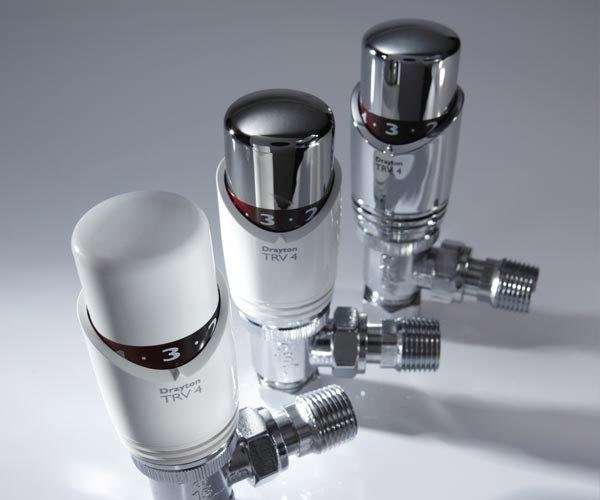

In the process of heating, the working substance begins to increase in volume, thereby stretching the cylinder. The latter begins to press on the piston, which in turn drives the shut-off cone on the valve.
The cone completely or partially blocks the flow of the heat agent, which is why the working substance in the thermostatic head begins to cool down. In the process of cooling, the volume of the substance decreases, and as a result, the elastic element lifts the closing cone. The coolant will again enter the heating radiator, and the head will be heated again.
Thus, thermostatic valves help to precisely control the temperature with high precision (down to one degree Celsius).
The principle of operation of the thermal head of the radiator
• the user sets a certain temperature regime that is comfortable for living;
• in the event of an increase in the temperature inside the room, the gaseous substance in the bellows begins to heat up, thereby putting pressure on the valve stem;
• the supply of coolant to the radiator decreases or stops altogether (water supply is carried out through the bypass);
• a decrease in the heating of the radiator leads to a decrease in the temperature in the room.
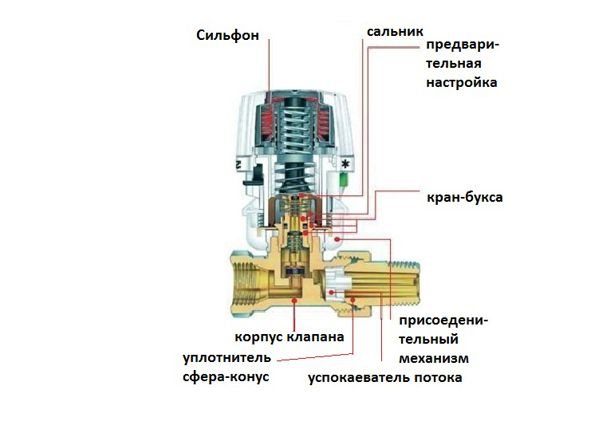

How to choose
When choosing a thermal valve, you need to take into account all the existing features of the heating system
Based on the characteristics of the heating system, as well as the conditions of its installation, in order to control the temperature, it is possible to use various combinations of valves and thermal heads.
So, for example, valves with a higher flow capacity should be used for use in one-pipe systems.
The same applies to those two-pipe systems in which the circulation of water is carried out by gravity, that is, in a natural way, without forced mechanisms. In cases where a two-pipe system is used, where there is a circulation pump, it is recommended to select those types of valves where it is possible to adjust the throughput.
After choosing the valve, it is necessary to select the thermal head.
The most common options that can be purchased today are:
- having an internal thermoelement;
- electronic (which can be programmed);
- having an external temperature sensor;
- anti-vandal;
- having an external regulator.
Most often, classic thermostats with an internal version of the sensor are installed in cases where their axis will be in a horizontal position.
Please note: the thermostat must not be installed vertically, since the heat emanating from the body piping will strongly affect the bellows, due to which the entire device will not function correctly.
In cases where it is not possible to mount the head horizontally, it is best to install an additional external temperature sensor with a special capillary tube.
In addition to vertical installation options, there are also other reasons to purchase a remote sensor version:
- in the event that heating radiators with a temperature controller located on them will be located behind the curtains;
- when there is any other heat source next to the installed thermal head;
- if the location of the battery is under a large windowsill.
Very often, in those rooms where the requirements for the interior are increased, the batteries are covered with decorative screens.Due to this, the internal thermostat will only register the temperature that is inside this casing. This will block access to the thermal head adjustments. Therefore, in such cases, it is recommended to stop your choice on a remote controller with a thermal sensor.
Worth knowing: if you have not yet purchased heating radiators, you can buy Kermi models with built-in temperature sensors.
If we talk about electronic thermostats with a display, then they are of several types, the former have a built-in control unit, and the latter have a removable one. The latter have the feature of the ability to detach from the thermal head, while it will continue to work in the same mode. The purpose of such models is to implement temperature control in different modes, at different times of the day. This makes it possible to reduce the level of heat during the day, and at night, when the whole house is asleep, to raise it to the desired level. Due to this, it is possible to significantly save energy.
If there are small children in the family who always want to touch and twist everything, it is recommended to install anti-vandal thermostats. This will protect the device settings from unauthorized interference. The same situation applies to options installed in various public buildings, ranging from kindergartens to hospitals.
Thermostatic head selection rules
You need to choose a device taking into account the characteristics of the heating system and its installation. Based on this, a valve and thermostatic head for radiators are used to control the temperature. Moreover, they can be combined in different versions.
For example, for one-pipe systems, it is better to use valves with a high flow capacity. Similar elements are suitable for two-pipe systems with natural circulation of the working medium. For two-pipe systems with forced movement of the coolant, the best option would be to install a thermal head on the radiators, which allows you to adjust the throughput.
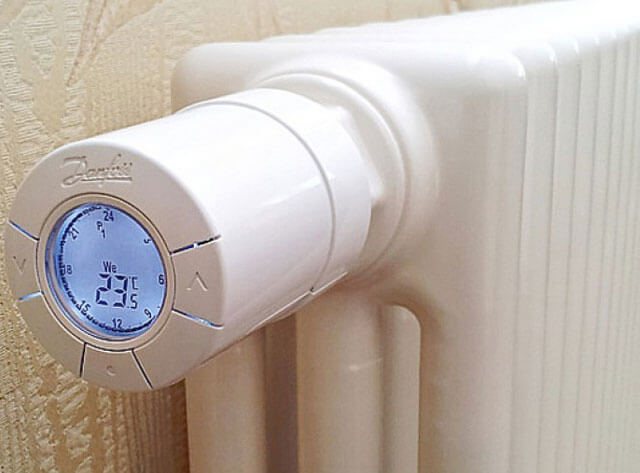

The choice of a thermal head for a radiator should also be approached responsibly. The most common are the following options:
- With a thermocouple installed inside.
- Programmable.
- With external temperature sensor.
- Anti-vandal.
- With external regulator.
The classic option is a thermostat that has an internal sensor and is located horizontally. It is not recommended to connect the thermal head to the radiator in a vertical position. In this case, the rising heat can cause the thermostat to malfunction.
If it is not possible to perform horizontal installation of the thermal head on the heating radiator, then an external sensor with a special capillary tube is additionally mounted.
Setting the thermostat


For the correct setting of the temperature controller, it is necessary to reduce to the lowest possible heat loss in the room. The thermometer should be located where there will be a constant temperature. After that, we turn the head of the thermal regulator to the left to the end, opening the valve, as a result of which the maximum heat transfer is achieved. As soon as the temperature increases by 5-6 degrees, the valve is closed by turning the head in the opposite direction.
After reaching the required temperature level, we begin to carefully open the valve. The setting ends when the sound of water in the regulator is heard and the rapid heating of the valve becomes noticeable.
It is best to entrust the installation of thermostats on heating radiators to professionals who will carry out the connection according to the manufacturer's instructions. Correctly installed equipment will allow you to create an optimal temperature regime in the room and ensure a rational consumption of thermal energy, which will have a beneficial effect on the financial costs of the family.
Remote temperature sensor
The use of an external sensor is necessary in several more cases:
- Heating radiators with a thermostat are closed with blackout curtains.
- An additional source of thermal energy is located in the immediate vicinity.
- The battery is located under a large windowsill.
Sometimes heating radiators are covered with decorative screens. This situation is observed in rooms with increased requirements for the interior. In this case, the internal thermostat only registers the temperature behind the decorative trim. In addition, access to the thermal head becomes difficult. To solve the problem, a thermal head is installed for a heating radiator with an external sensor.
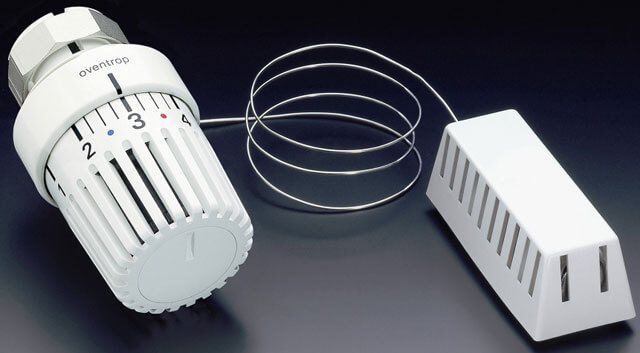

As for the programmable devices, they are equipped with displays for visual control and are also divided into two types. Some of them are equipped with a built-in control unit, while others have this element removable. The second option has some advantage: the disconnected control unit continues to operate as before. At the same time, it is important to control how the thermal head on the heating radiator works.
Such models allow you to adjust the temperature individually for a specific situation. For example, during the day you can reduce the temperature values, and at night - increase. As a result, the savings are quite serious.
Vandal-proof devices are ideal for homes where there are small children who touch and twist everything. Therefore, it is important to know and understand how to install the thermostatic head on a radiator. Thermoregulators of this type do not allow you to knock down the settings if handled carelessly. It is also used in public buildings, including kindergartens and hospitals.

